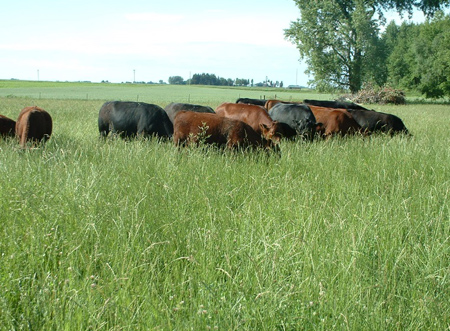Tall fescue has long been associated with a syndrome known as Summer Slump (a.k.a. Fescue Foot or Fescue Toxicosis). An endophyte fungus within the fescue plant produces alkaloids that cause adverse symptoms including: decreased weight gains, weight loss, decreased feed intake, reduced milk production, higher body temperature, increased respiration rates, rough hair coat, unthrifty appearance, loss of blood flow to extremities, excessive salivation and poor reproductive performance. Symptoms seem to be worst during hot summer months. Table 1 illustrates the differences in weight gain in steers on both high- and low-endophyte fescue diets.

Dealing with Summer Slump
There are several management options available to cattle producers to help lessen the symptoms of Summer Slump:
How Can I Help My Cattle Avoid Fescue Toxicity Symptoms?
Replacement of Infected Fescue Pastures
When attempting replacement, take a "spray-and smother" approach. First spray the infected field with an effective herbicide, second seed a cover crop to smother the field, then reseed with the desired new forage crop. The smother crop should be a fast growing annual forage (millet or sudangrass in the summer, or wheat, rye or oats for fall). It is usually a good idea to renovate small portions of the farm at a time.

Rotating cattle to non-fescue pastures during the hottest periods of the year helps to combat Summer Slump.
Rotation to Non-Fescue Pastures
Rotating cattle off of fescue pastures during hot summer months increases animal performance for several reasons. First, because fescue is a cool-season forage it stops growing during hot summer months. Rotating cattle off fescue onto growing, warm-season pastures simply gives them more to eat. Secondly, high temperatures seem to intensify the negative effects of the endophyte toxins. Moving cattle to non-infected pastures eliminates this interaction. Cattle need to stay off infected-fescue pastures for the entire summer to gain benefits. Taking cattle off for only a few weeks at a time will not greatly reduce summer slump symptoms.
Dilution
Interseeding infected fescue pastures with legumes helps dilute the total toxins ingested as well as increasing the overall nutritional content in the pasture. These legumes must be managed to allow reseeding each year. And even with special management, many need to be manually reseeded periodically. It is also important to fertilize for the legume (limiting the amount of nitrogen) in order to allow the legumes to thrive.

Mineral supplementation, especially copper and zinc, can help offset some of the deficiencies caused by fescue forages that contribute to Summer Slump.
Mineral Supplementation
Research has shown that copper levels are lower in endophyte-infected fescue vs. endophyte-free fescue when grown under identical conditions. These differences are most pronounced late in the growing season (See Table 2). These findings support observations of decreased copper status in cattle grazing infected fescue. In research conducted in Virginia, cattle grazing endophyte-infected fescue exhibited decreased copper status as opposed to cattle grazing endophyte-free fescue. However, the magnitude of this decrease was greater than the difference between the forages. This demonstrates that the endophyte not only decreases the total amount of copper present in the fescue, but also, negatively affects bioavailability of copper for the animal. This makes sense when you consider that the typical symptoms for fescue toxicosis closely resemble those for copper deficiency. These symptoms include rough, discolored hair coats; winter coats that are slow to shed out; decreased conception rates; increased days open; hoof problems; and depressed immunity. For all of these reasons, lowered copper status plays a large part in the fescue toxicosis syndrome. Proper supplementation with a high copper supplement can help alleviate some of the fescue toxicity symptoms.


